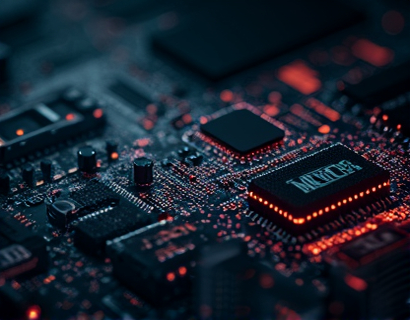Advanced Layer 2 Solutions: Transforming Blockchain Scalability and Developer Efficiency for EVM-Enabled Applications
In the rapidly evolving landscape of blockchain technology, scalability and developer efficiency have emerged as critical factors for the widespread adoption of decentralized applications (dApps). For Ethereum Virtual Machine (EVM)-enabled applications, these challenges are particularly pronounced due to the inherent limitations of the Ethereum blockchain. Advanced Layer 2 (L2) solutions are revolutionizing the way developers approach blockchain development, offering enhanced scalability, security, and efficiency. This article delves into the transformative impact of these solutions, focusing on how they are reshaping the future of blockchain innovation.
Understanding Layer 2 Solutions
Layer 2 solutions refer to technologies built on top of existing blockchain networks (Layer 1) to improve transaction throughput, reduce costs, and enhance overall performance. Unlike Layer 1 upgrades, which involve modifying the core protocol, L2 solutions provide a more flexible and faster way to address scalability issues. For EVM-based blockchains, L2 solutions are particularly valuable as they maintain the security and decentralization of the underlying network while offloading some of the computational load.
Key Benefits of Advanced L2 Solutions
One of the primary advantages of advanced L2 solutions is their ability to significantly increase transaction throughput. By processing transactions off the main blockchain, these solutions reduce the congestion that often leads to high gas fees and slow confirmation times. This improvement in scalability is crucial for EVM-based applications, which often require high transaction volumes, such as decentralized finance (DeFi) platforms and gaming applications.
Security is another critical aspect where advanced L2 solutions excel. By leveraging techniques such as state channels, sidechains, and plasma, these solutions ensure that transactions remain secure and verifiable on the main blockchain. This dual-layer approach not only enhances performance but also maintains the integrity of the decentralized ecosystem.
Developer efficiency is a third key benefit. Advanced L2 solutions provide developers with tools and frameworks that simplify the process of building and deploying dApps. This includes streamlined development environments, automated testing, and deployment pipelines, which reduce the time and resources required to bring new applications to market.
State Channels: A Deep Dive
State channels are one of the most promising L2 solutions for EVM-based applications. They enable multiple transactions to occur off-chain, with only the final state being recorded on the blockchain. This mechanism drastically reduces the number of on-chain transactions, thereby lowering gas costs and increasing transaction speeds.
For developers, state channels offer a flexible and scalable solution for building applications that require frequent and fast transactions, such as payment systems and multiplayer games. The challenge lies in managing the complexity of channel opening, funding, and closing, but various frameworks and libraries are emerging to simplify these processes.
Sidechains: Enhancing Scalability and Interoperability
Sidechains are independent blockchains that are linked to the main blockchain, allowing assets and data to be transferred between them. For EVM-based applications, sidechains provide an additional layer of scalability by processing transactions off the main chain. This offloading not only reduces congestion but also allows for the implementation of custom consensus mechanisms and features tailored to specific use cases.
Interoperability is a significant advantage of sidechains. They enable seamless interaction between different blockchain networks, facilitating the creation of decentralized ecosystems that span multiple platforms. For developers, this means greater flexibility in choosing the most suitable blockchain for each component of their application, optimizing performance and cost.
Plasma: Scaling Through Subchains
Plasma is a scalability solution that involves creating a network of subchains (plasmas) that are anchored to the main blockchain. Each plasma processes a batch of transactions, and the results are periodically settled on the main chain. This approach allows for a massive increase in transaction capacity while maintaining the security of the underlying network.
For EVM-based applications, plasma offers a robust solution for handling high-volume transactions, such as those in DeFi protocols and non-fungible token (NFT) marketplaces. The modular nature of plasmas also allows developers to scale individual components of their applications independently, enhancing overall system resilience.
Optimistic Rollups: Streamlining Transactions
Optimistic rollups are another advanced L2 solution that bundles multiple transactions into a single transaction on the main blockchain. These solutions operate under the assumption that the transactions within the rollup are valid, and only challenge transactions are processed on the main chain. This approach significantly reduces the load on the main blockchain, leading to faster transaction times and lower fees.
For developers, optimistic rollups simplify the process of building scalable dApps by abstracting the complexity of transaction validation. The focus shifts from ensuring the validity of each individual transaction to managing the occasional challenge that may arise. This streamlined approach accelerates development and deployment cycles.
Zero-Knowledge Rollups: Enhancing Security and Privacy
Zero-knowledge rollups take the concept of rollups a step further by using zero-knowledge proofs to bundle and verify transactions off-chain. This cryptographic technique ensures that the final state submitted to the main blockchain is correct without revealing the underlying transaction data, enhancing both security and privacy.
For EVM-based applications that handle sensitive data, zero-knowledge rollups provide an excellent balance between scalability and security. Developers can leverage these solutions to build applications that require high levels of data confidentiality, such as privacy-focused DeFi protocols and identity verification systems.
Developer Tools and Ecosystem Support
The success of advanced L2 solutions hinges on the availability of robust developer tools and ecosystem support. Various projects and platforms are emerging to provide developers with the necessary resources to build and deploy scalable dApps. These include integrated development environments (IDEs), testing frameworks, and deployment tools that simplify the development process.
Community support and documentation are also crucial. Active developer communities and comprehensive documentation help new and experienced developers alike to overcome challenges and leverage the full potential of L2 solutions. This collaborative ecosystem fosters innovation and accelerates the adoption of advanced Layer 2 technologies.
Case Studies: Real-World Applications
To illustrate the transformative impact of advanced L2 solutions, consider a few real-world applications. A DeFi platform implemented state channels to handle high-frequency trading, resulting in a 90% reduction in gas fees and a significant increase in transaction speed. Another example is a gaming platform that utilized optimistic rollups to enable seamless in-game transactions and asset transfers, enhancing user experience and retention.
These case studies demonstrate that advanced L2 solutions are not just theoretical concepts but are being successfully implemented to solve real-world problems in the blockchain space. As more developers adopt these technologies, the potential for innovation and growth in the decentralized ecosystem continues to expand.
Future Prospects and Challenges
The future of blockchain scalability and developer efficiency is bright, with advanced L2 solutions leading the charge. However, several challenges remain, including the need for standardization, interoperability between different L2 solutions, and the ongoing optimization of existing technologies. The blockchain community is actively addressing these issues, and ongoing research and development efforts are paving the way for even more advanced and user-friendly L2 solutions.
As the ecosystem matures, we can expect to see a broader adoption of advanced L2 solutions across various industries, from finance and gaming to supply chain and beyond. The synergy between scalable L2 technologies and EVM-based applications will continue to drive the evolution of decentralized systems, making them faster, more secure, and more accessible to a global audience.










































